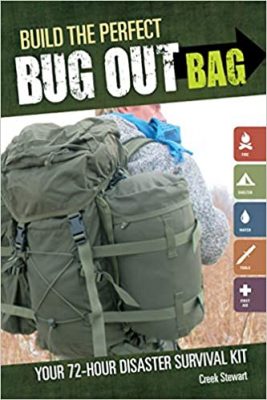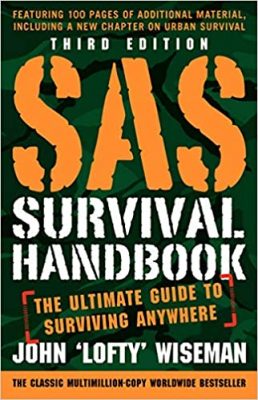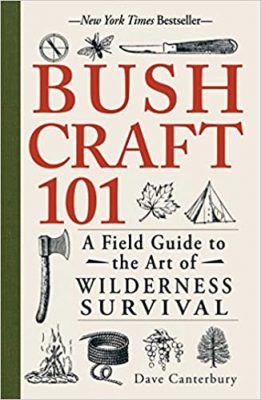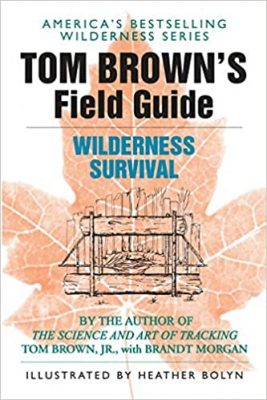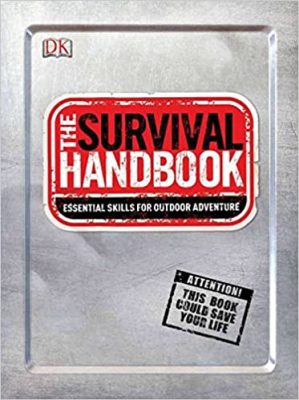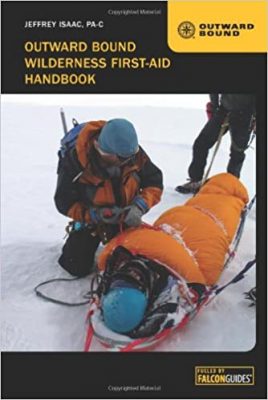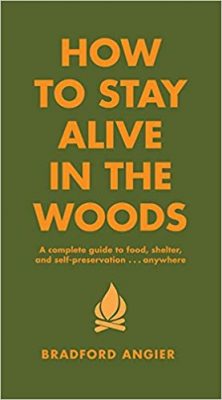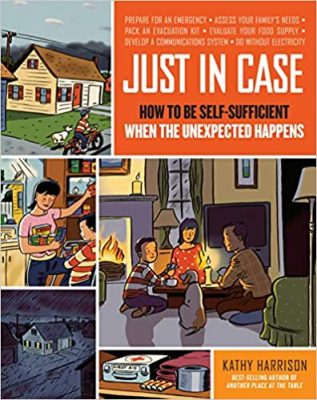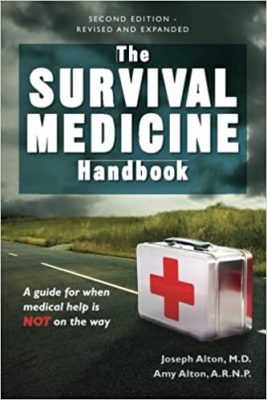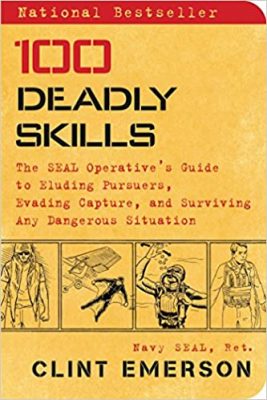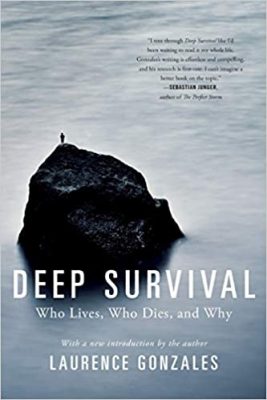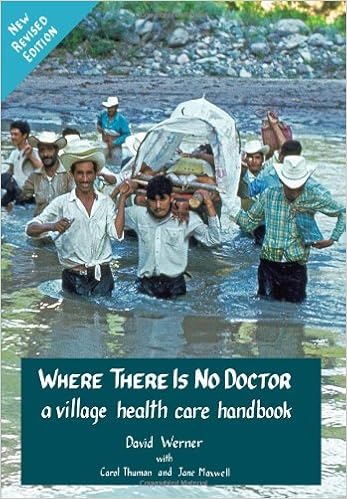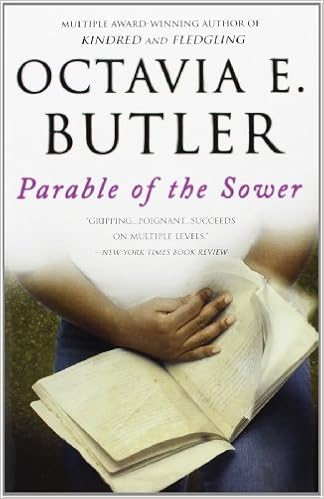Survival doesn’t only happen outdoors. It happens when we least expect it. It happens even inside our homes. That’s why having the best survival books are good.
It’s common for us to prepare for things we expect will happen. But what about things that might happen when we least expect it? This article discussed the best survival books you can find on the market! These books cover things from what to do in wilderness survival all the way down to the plants we can eat!
Knowledge is power. And you will have power with the best survival book.
| Quick Navigation Definition of Terms Buyer’s Guide Questions Wilderness Survival Books Urban Survival Books Wild Plant Survival Books Homesteader Survival Books Fictional Survival Books |
|---|
What is Survival?
The textbook definition of survival is the state of enduring despite adverse circumstances. This can be applied not only in situations outside our homes but also inside.
These survival books talked about all kinds of things. It discussed primitive skills you can learn by yourself. It will educate you on what plants are safe and what isn’t. It also talked about home repairs and the like!
This article will outline terms you may not be familiar with. It will give you some frequently asked questions (FAQs) on survival. Additionally, it will provide you some guide questions to help you choose the best survival book.

Definition of Terms
Whether you are a novice or a seasoned prepper, here is a refresher that will discuss the terms you will encounter later in this article. You will also encounter them in our list of the best survival books.
- Bug out Bag. This bag has nothing to do with bugs; however, it does have everything to do with survival. It’s a portable survival kit which you can bring as a carry-on. Its contents should last for 72 hours.
- Bushcraft. Its textbook definition is the skill to survive in a natural habitat. It’s a term that is said to be popularized by Les Hidins in the southern hemisphere, Australia (in the northern hemisphere, it was done by Mors Kochanski).
- Foraging. It’s a similar term to bushcraft, but it differs in a few details. Bushcraft is a general term for wilderness survival, but foraging is not. Foraging mostly deals with food and provisions.
- Ham Radio. A ham radio (aka amateur radio) is a communication device. The term ham was a derogatory nickname. It was first used by amateur radio operators in 1909. The name stuck since then.
- Homesteading. A homestead is an isolated dwelling, usually a farmhouse. By extension, it can also mean a small cluster of houses.
Frequently Asked Questions when it comes to survival
Here are some of the frequently asked questions about wilderness and survival in general. Some of these questions may have been answered in the list of survival books we have prepared.
- What is most critical in wilderness survival?
You might say – be prepared. However, you’re already out camping. The most critical part is to STAY CALM. Classic advice, but it does save lives.
- What are the five keys to wilderness survival?
The five keys to wilderness survival are: (1) how to build shelters, (2) what to eat and how to find it, (3) how to build and maintain a fire, (4) how to find water, and lastly, (5) how to get help.
- What common mistakes do people make in the wilderness?
There are a variety of common mistakes anyone can make in wilderness survival. You can lack or have poor navigation skills. You may have miscalculated during prepping. You can even wear inappropriate clothes. There’s a lot more, but those are just a few of the common mistakes people make.
- What is the best way to pin your position in the wilderness?
You ultimately want to find a way back to familiar grounds when you get lost. To do that, you will have to know exactly where you are. Expert advice is to establish a road (or river) as a baseline. It’s easier than trying to find a prominent peak or landmark in your map.
- What do you do when you’re lost?
It’s directly related to the previous FAQ. When you finally realize you’re lost, DON’T PANIC. All you have to do is retrace your steps. It’s easier done with a baseline.
- Which place is the warmest to camp in when the sun goes down?
Keeping warm is important especially in the wilderness. The best advice is to find a north-facing slope because although it’s colder during the day, it stays warm at night.
Buyer’s Guide Questions when choosing the best survival book
After reading the FAQs and familiarizing yourself with the common terms, it’s time to know how to choose the best survival book. Remember, there are quite a few out there.
You are probably thinking: what’s wrong with buying every survival book out there? Answer: nothing. The only problem with that is you might not have enough space in your bag. That’s why we have guide questions for this – these will help you choose your best survival book.
Question 1. What is your outdoor experience?
It’s the first consideration you should have before buying. If you’re a beginner, you will need a survival book that beginners can easily understand. If you’re an expert, then perhaps some specialized survival books will be up to your tastes.
Question 2. What topics/areas do you want to learn more about?
It’s the second consideration. If you’re not interested in the topic of the survival book, why bother? That’s why there’s also some fictional survival books included in our list. If you’re more of a reader than a technical person, you might want to check that list out.
Question 3. Which scenario concerns you the most when it comes to survival?
Some of the essential survival books we’ve compiled are rather specialized. If you’re worried for a particular scenario, then choosing a survival book about said scenario is best for you. Some of them are also a compilation of everything compressed into one book. If you are not sure what to expect, you can refer back to the FAQs.

Creating Your Own Essential Survival Books’ Library
There’s nothing wrong with buying multiple survival books. You can even make your own survival book library. However, you cannot carry a library.
If you do decide on a library, an established system is very helpful. Survival books can be categorized into two major things: (1) non-fiction and (2) fiction. Each category comes with their own subtopics.
But first, you will need books for the library. Here are a few lists we have compiled for you.
List of Non-Fiction Survival Books
Non-fiction books are books made with facts. It’s made by real people with real experiences.
Survival books are as technical as they can get. You can’t make a book about survival without experiencing them first. You may be able to do that in fictional survival books, but not for non-fiction.
Within the non-fiction category, there are four main types of non-fiction survival books. You have books pertaining to wilderness survival. You may find some to be about urban survival. You can also go for more specialized survival books such as plants and herbs and homesteading.
Wilderness Survival Books
Wilderness survival books mostly deal with what to do outdoors. Everything from what to prepare, and how to survive outside is discussed in these books.
Here’s an additional list of wilderness survival books you might want to check out.
While these are some of the few notable wilderness survival books, we have a comprehensive guide of the popular best wilderness survival books.
Best Wilderness Survival Books
1. Build the Perfect Bug Out Bag: Your 72-Hour Disaster Survival Kit
This book was written by Creek Stewart, one of the well-known prepper authors. His knowledge mostly comes from experience. He is a frequent guest survival expert in media platforms, as outlined in his website. He’d also been awarded in 2015 with the NOESA (NESA Outstanding Eagle Scout Award). This is a prestigious award granted to Eagle scouts who demonstrated outstanding achievements.
This survival book is perfect for beginners as well. While it says 72-hour disaster kit, to anticipate more than that timeframe is better. The survival book outlines around eleven categories, each with its own advantages, drawbacks, and importance in survival. Categories include:
- Water
- Food
- Clothing
- Shelter or bedding
- Fire
- First-Aid
- Hygiene
- Tools
- Lighting
- Communication
- Protection
The book also covers additional information about the following:
- Selecting the pack
- Traveling with pets
- Organization and maintenance of BOB (Bug Out Bag)
- Mental Preparedness
- Plan Development
- Practicing your skills
With easy-checklist pages you can find at the end of the book, you can build your perfect bug out bag quite easily.
2. The SAS Survival Handbook: The Ultimate Guide to Surviving Anywhere
This survival book was written by John “Lofty” Wiseman. He joined the Parachute Regiment in 1958. He also applied for service by 1959 in the Special Air Service Regiment. He went into active service worldwide for 26 years.
This survival book is the perfect companion if you need to evacuate. You can also use it to learn to survive in any type of situation. In this book, Wiseman includes three important learnings for every survivor:
- The will to live
- Knowledge
- Your survival kit
It’s the foundation of every lesson he imparts in this book!
This book will teach you about the following things:
- How to be prepared. Do you know how to read the weather? Or which essentials to prepare? It’s in this book.
- How to make camp. Learn how to find your best camping location, as well as shelter construction and organization. You also learn how to stay warm and how to create your own survival tools.
- Survival Food. Learn what you can and cannot eat (this also includes where to find it). The book will also teach you how to prepare your own food.
- First-aid. The book includes a comprehensive guide on emergency or wilderness medicine. You will also read about how to survive in any weather.
3. Bushcraft 101
This survival book was written by Dave Canterbury. He’s a survival expert at wilderness living! He’s got 40 years of experience under his belt. He’s written guide books, instructed in schools, and sold high- quality gear at his online store.
Bushcraft 101, and its sister book Advanced Bushcraft, cover different topics such as creating your own survival kit, tools and supplies, scavenging food and cooking, and how to protect yourself, to name a few. It was also dubbed as “the ultimate resources for experiencing the backcountry”. It’s based on Canterbury’s 5Cs of survivability:
- Cutting tools
- Covering
- Combustion devices
- Containers
- Cordages
4. Tom Brown’s Field Guide to Wilderness Survival
Tom Brown Jr. and Brandt Morgan authored this book. Tom Brown, Jr. was dubbed as America’s most acclaimed outdoorsman. He is also a renowned tracker, teacher, and author. For ten years he’s wandered the wilderness, and he did it without using manufactured tools.
The book cover will tell you that it is about the “basics of wilderness survival.” It features some of the most ancient (and important) skills that’s been preserved for generations! It also uses an easy format for simple presentations. It’s designed for beginners, as well as experienced adventurers! This field guide contains the following information:
- How to build natural shelters in plains, woods, and deserts
- How to get safe drinking water from plants, trees, the earth, and even the sun
- How to make fire without any matches and maintain the fire regardless of the weather
- How to find, stalk, and kill animals for food; as well as the preparation
- The big four edible plants, and many others that are good for medicine and nutrition
5. The Survival Handbook: Essential Skills for Outdoor Adventure
The survival book’s author, Colin Towell, joined the Royal Navy in 1977. He later qualified as a Combat Survival instructor. He taught survival skills in the UK and USA to the army, marines, navy, and the air force.
It’s a book that tackles several topics – such as planning expeditions and info on what to do on a trail! It’s a big book with thorough information on survival. It also includes different scenarios and climates; Thus, it covers just about any survival condition. It also has illustrations that will engage young readers. This survival book teaches you the following:
- How to make shelters
- Find water
- Spot, catch, and cook wild animals for food
- Essential first-aid
- How to mount a rescue
- How to get yourself found
6. The Outward Bound Wilderness First-Aid Handbook
Jeffrey Isaac, PA-C is the President of Medical Officer, Ltd. He is also a curriculum director for the Wilderness Medical Associates International. He has 40 years of emergency medical experience, outdoor education, and wilderness rescue.
This book is a detailed medical book. It’s filled with technical information that was written in easy-to-understand language. It’s perfect for people who loves the outdoors. It even covers many scenarios one would face in the wilderness.
It includes logical information regarding injuries and illnesses. Whether it’s muscular or skeletal injuries (or even dental problems), you will find it there. It’s also based on the Wilderness Medical Associates curriculum on essential first aid and diagnostics.
7. How to Stay Alive in The Woods: A Complete Guide to Food, Shelter and Self-Preservation Anywhere
This is a Bradford Angier book. Bradford Angier was an American wilderness survivalist and author. He has written over 35 books about how to survive the wild and live a minimalist life on land.
This survival book, How to Stay Alive in the Woods, is an absolute classic! You can even carry it easily. It has solid content overall, although it’s illustrations may fall short on some details. It does use some dated language; after all, it was written in 1956.
This survival book is broken down to four sections:
- Sustenance
- Warmth
- Orientation
- Safety
Urban Survival Books
Urban survival books also have tips on how to survive, but this category mostly deals with an urban setting such as locations within cities with modern technology.
Best Urban Survival Books
8. Just in Case: How to be Self-Sufficient When the Unexpected Happens
Kathy Harrison authored not only this survival book, but also another book entitled Prepping 101. She’s a national spokesperson. She’s also given lectures and tours about family preparedness and foster parenting. She has appeared on NPR interviews, Oprah, and The Today Show.
It’s a great beginner’s survival book! It’s introduction is some of the best for household preparedness. The book starts with a story about two hypothetical families. The given scenario is a winter storm with a power outage. In the book, it compares the experiences of the unprepared and the prepared family.
The rest of the book follows through several disaster scenarios such as:
- Power Outage
- Fire
- Pandemic
- Terrorism
9. The Survival Medicine Handbook
This book was written by Joe Alton, MD and Amy Alton, ARNP. The Altons won first place in the 2017 Book Excellence award with this survival book. They have also published many books and editions.
Most medical survival books would focus on the stabilization and transport of the injured party, but not this one. As a retired medical doctor and a nurse practitioner, the Altons wrote the book specifically to prepare the readers for situations of widespread emergency or social collapse. This book is also catered to readers with no previous medical background.
One of their main case-in-point are the events that took place in Hurricane Katrina. The hospitals were quickly overwhelmed by the influx of patients due to being understaffed and undersupplied. The book includes:
- Basic Principles
- Prevention
- Sanitation
- Types of illnesses and injury, and
- Medications
10. 100 Deadly Skills: The SEAL Operative’s Guide to Eluding Pursuers, Evading Capture, and Surviving Any Dangerous Situation
This survival book was written by Clint Emerson. He has served in the Navy for 20 years (includes stints with SEAL Team Three and SEAL Team Six). He also runs a crisis management consulting company named “Escape the Wolf.”
This survival book is based on real life field experiences in special forces operations. It’s also been adapted to be suitable for civilians. Personal safety is also included in survival. True, most survival emergencies come from mother nature; however, it wouldn’t hurt (and it would also be advantageous) to know some self-defense. This survival book will teach you:
- The basics of securing your shelter
- How to build a fire
- How to find food
- Techniques on how to survive a hostage situation, active shooters, suicide bombers and even terrorist threats
11. Deep Survival: Who Lives, Who Dies, and Why
Laurence Gonzales is a multi-awarded bestselling author. Among his achievements include, but are not limited to: two (2) National Magazine Awards and the Distinguished Service Award. In 2018, he received the Montaigne Medal from the Eric Hoffer Society. He also received the Eric Hoffer Award in 2018 and 2019.
The survival book, Deep Survival, explored the human mind in the face of emergencies. While it’s great to stock up on skills, the best survival books will also mentally prepare you.
The focus of the book’s first section are disasters. How do disasters unfold? What are the things that people can do during this event? Many of the answers found in this book seemed to be in contrast to what we see in movies. Gonzales wraps up to cognitive science with real-life stories, much like an adventure novel.
Its second section provided words of wisdom and caution from survivors. Each of the narratives provided have pinpointed some common problems such as a plan’s inflexibility. He also included some habits you can practice every day that will help you stay alive, and may also help others in times of crisis.
12. When Violence is the Answer: Learning How to Do What it Takes When Your Life is at Stake
It’s another self defense book in our list. This survival book was written by Tim Larkin. He’s a leading Pro-Victim Rights and Personal Safety Advocate. He’s been named as the 2011 Self Defense Instructor of the Year, and inducted simultaneously to Black Belk Hall of Fame.
This book deconstructed society’s usual assumption that pertains to violence. (this also includes morality, function in society, and how it works). He removes any shackles we might have to enable us to protect, prepare and survive unanticipated life-threatening events. This book covered topics on tactics and techniques when faced with asocial violence.
What makes it different from the others is that its focus is mostly on the psychological, emotional, and social patterns that make us hesitate to use violence. He also admitted that violence is a rare option; However, he also proceeded to state that when violence is present, violence is the only answer.
13. The Ultimate Prepper’s Guide: How to Make Sure the End of the World as We Know it Isn’t the End of Your World
Jay Cassell specialized in books that pertain to hunting, fishing, and shooting. We do have a simple warning though; the survival book does include graphic explanations on how to process or take apart the bodies of dead animals. This also includes how to shoot the live ones. It’s all very clinical and thorough.
The main feature this survival book has is its do-it-yourself (DIY) approach. It has amazing diagrams and illustrations, despite the poor paper quality. It’s packed with practical approaches, step-by-step instructions, and how-to explanations. It’s also quite easy and simple to understand. It even includes info on how to prepare your own budget. Its chapters include:
- Basics of preparedness
- Communications
- Resource Conservation
- Power and Energy
- Emergency Heating and Cooling
- Water, food and nutrition
- Shelter
- Evacuation
- Public Health
- Special Needs
- Specific Hazards
It’s certainly the ultimate survival book.
Wild Plant Survival Books
You guessed it! This type of survival book deals mostly with plants. The information included here ranges from what plant to eat, all the way down to how to use it for medicinal purposes. It also deals with anything related to nature, and that includes water. With these books on hand, you’ll less likely poison yourself like Foxface did in The Hunger Games movie.
Best Wild Plant Survival Books
14. Peterson’s Field Guide to Edible Plants
Lee Allen Peterson is a degree holder in Natural Sciences from the John Hopkins University. He’s also acquainted with the field guide approach that was created by his father, Roger Tory Peterson.
It has about 400 plant descriptions; all of them are found throughout half of eastern US. It’s concise and detailed, though you might find fault in some of the black and white illustrations. The book tells you which plants are suitable to use for:
- Salads
- Teas
- Root vegetables and many more
It also tells you:
- The plant’s habitats
- List of plants per season
- Preparation instructions for twenty-two different food use
15. Edible Wild Plants: A North American Field Guide to Over 200 Natural Foods
This survival book was written by Thomas Elias and Peter Dykeman. It’s the best field guide about foraging in the North American Wilderness. Elias and Dykeman had organized the books with the information on the edible plants all around the seasons!
Each plant entry of the book includes:
- Photos
- Habitats
- Physical properties
- How to harvest
- Preparation
- Poisonous look-alikes
It doesn’t include any endangered and threatened plants though. It also doesn’t include anything about mushrooms and other fungi. It’s because misidentification is very common and serious.
16. The Prepper’s Water Survival Guide: Harvest, Treat and Store Your Most Vital Resource
Written by Daisy Luther, this survival book focused on water preparedness. Water is our most basic need as a human being. You can take away food for a couple days and we’d still survive, just don’t take away the water supply.
Water can be cut short not just by natural disasters, it can also be due to political problems in the state, or even human error. With this book, you will learn how to:
- Store fresh water
- Collect rainwater
- Purify the water from lakes and/or rivers
- Dig a well
Luther also included tips on water conservation. You will also gain some tools on how to keep your stored water untainted for long periods of time and how to test your water for toxins (as well as treat common water-related illnesses).
17. Backyard Foraging: 65 Familiar Plants You Didn’t Know You Could Eat
Ellen Zachos is a garden writer and photographer. She authored six other books aside from Backyard Foraging. She’s a regular contributor to several Edible magazines. She is also a Senior Regional Advisor at Garden Compass (it’s a plant identification application).
Her book on North American urban and suburban foraging mostly included those plants that are commonly seen in our day-to-day lives. With it, you can create your own food forest inside your home.
Plants are seen everywhere. Although not as plenty in the wilderness, you can forage some plants in your very own backyard. This book featured around 70 edible weeds, flowers, mushrooms, and ornamental plants. It also included tips on:
- Common plant locations
- Pesticides
- Pollution
- Dangerous floras
18. The Complete Medicinal Herbal: A Practical Guide to the Healing Properties of Herbs
Penelopy Ody is a freelance journalist for more than 30 years. She qualified as a medical herbalist in the 1980s. She also practiced it part-time for 11 years.
Her book on herbal medicine covered specific information – how to make and use your own brewed herbal medicines. It’s packed with pictures to make sure you’ve got the correct plant in hand, even more so in the Dorling Kindersley edition.
This survival book has profiled over 120 medicinal herbs, complete with their traditional uses! Some of the many details for these herbs include:
- Which plant parts are suitable
- Preparations
- In which season the plant’s parts should be harvested and many more
19. Gaia’s Garden: A Guide to Home-Scale Permaculture
Toby Hemenway was awarded with the Nautilus Gold Medal in 2011 for this book. It was also named in the Washington Post as one of the ten best gardening books of 2010.
This survival book, Gaia’s Garden, can also be considered as a homesteader survival book. It’s also a classic introduction to permaculture. While normal agriculture requires blood, sweat and tears, permaculture does not. It organizes the plants and landscapes into an ecosystem, a self-sustaining food forest if you will. The book includes:
- How to build and maintain the soil’s fertility and structure
- How to catch and conserve water in the landscape
- How to provide habitats for beneficial birds, insects and animals
- How to grow an edible forest that will provide you with fruits, nuts and plenty more every season
In its updated and revised edition, it also has an additional chapter about urban permaculture. If you’re looking to start your own forest food backyard, it’s certainly the book to buy.
Homesteader Survival Books
Homesteader survival books is a specialized category. Compared to wild plant survival books, the information on this book ranged from primitive skill learning to home repairs! It’s a fix-all survival book!
Best Homesteader Survival Books
20. Primitive Wilderness Living & Survival Skills: Naked into the Wilderness
The authors, John and Geri McPherson, are the leaders in the primitive technology field. Not only do they write about this stuff, but they also live it.
It’s an in-depth how-to book for primitive skills. It is also similar to Larry Dean Olsen’s Outdoor Survival Skills, but it doesn’t teach as much skills though. The main principle of this book is starting from ground zero. This means utilizing nature, because this is all you have to survive. It also teaches native American-inspired skills, such as, how to:
- Brain-tan deer skins
- Make sharp stone knives or blades
- Build a bow drill equipment, and many more
It’s certainly the best survival book to buy if you’re looking for more hands-on guidance on primitive living.
21. Primitive Skills and Crafts: An Outdoorsman’s Guide to Shelters, Tools, Weapons, Tracking, Survival and More
It’s a survival book written by Richard and Linda Jamison. Similar to Naked into the Wilderness, this survival book also talked about ancient skills and techniques. The difference is that it’s been adapted into modern society as well.
Everything is included in this book – from turning seashells into arrowheads to making glue from yucca plants. This survival book will also help you rediscover the ancient skills of:
- Firemaking
- Camp cooking
- Basket Weaving
- Pottery making
- Animal tracking
22. The Prepper’s Pocket Guide: 101 Easy Things You Can Do to Ready Your Home for Disaster
This survival book by Bennie Carr is also perfect for beginners! It’s also more about having preparedness than it is with prepping. It’s perfect for beginners because of its portability; it’s small enough to fit in your pocket.
It’s basically a book on financial preparedness more than anything else. She discussed 101 quick and simple DIY ideas in the book that includes, but not limited, to the following:
- To create your password master list
- How to calculate how much water you will need?
- Start a Food Storage Plan for just $5 a week
- Make a Hollowed-out-book Safe
- Assemble a cheap first aid kit
- How to cook with no electricity
- How to pack your bug out bag
23. Where There is No Doctor
This book, Where There is no Doctor, was written by David Wurner, Carol Thuman, and Jane Maxwell. It’s significantly older than the Survival Medicine Handbook by Dr. Alton; however this medicine book is certainly a classic when it comes to prepping!
This book also comes with a few companions called Where There is No Dentist andWhere Women Have No Doctor. It’s an indispensable resource, it’s packed with information on:
- Common illnesses
- Nutrition
- Child and elderly care
- Family planning
- Childbirth
Even the World Health Organization (WHO) mentioned that this book saved lives in the 1970s in second and third world countries.
24. The Complete Photo Guide to Home Repair
This book by Black & Decker has everything you will need when it comes to home repairs! Shelters are extremely important in survival. Our homes are important for us. It’s not a new thing to discover that after some time, things around our homes begin to break down.
This DIY repair guide certainly makes home repairs easier. If you can’t get a hold of your local repairman, you can just do it yourself. Here are some repairs you will find in this book:
- Water-damaged walls and ceilings
- Removing wall and ceiling surfaces
- Install entry doors
- Gutter repairs
- Water heater replacement
- Home Wiring troubleshooting
25. The Total Gun Manual: 335 Essential Shooting Skills
This book was been written by David E. Petzal and Phil Bourjaily. It’s the perfect book for any gun enthusiast out there. There aren’t many books out there whose sole focus is about guns. And even if you are against guns, it’s not bad to learn about it.
This book includes several diagrams, illustrations and photos. It will also teach you how to become a skilled and responsible gun owner. It’s good for someone who has zero knowledge on guns. Some of the topics covered are:
- How to choose the right gun
- How to shoot better
- Hunt Smarter
- Stay safe
26. Ham Radio for Dummies
Ham radios have been mentioned earlier in this article. This “for dummies” book is all about ham radios. This is very old technology; however, newer models of ham radios do have access to the internet. Some can even send pictures! But if you want to learn about how to operate the older models, this book is perfect for you.
Operating ham radios can be very tricky. It’s why you will need a license to operate. It’s also especially useful when mobile phones and other communication systems fail. With this book, you will learn:
- How to set up your radio station
- How to design you ham shack
- Provide support during emergencies
- Communicate with other ham radios
- Study for the licensing exam
- How to choose your own call sign
List of Fiction Survival Books
Fiction is a product of imagination. You can write about mythical creatures, and even new worlds! However, just because it’s fiction doesn’t mean you can’t learn from it.
With these fictional survival books, you can be assured that you will also learn some things along the way. It will also be an enjoyable read. It might even be a fresh perspective from the technical non-fiction survival books. Its scenarios include worldwide terrorism, cyberattacks, dystopian worlds, and even the zombie apocalypse! The sky’s the limit for the imagination after all.
For this category of survival books, here is our list of some of the best fictional survival books that have been published.
Best Fictional Survival Books
27. Light’s Out
Don’t mistake this book from “Light’s Out: A Cyberattack, A Nation Unprotected, Surviving the Aftermath”. This one was written by David Crawford. David Crawford is an enthusiastic adventurist. He is also a third-degree black belter in the American Society of Karate.
His book, Light’s Out, talked about a world where lights have gone out. It follows the story of a man named Mark “Karate Man” Turner. He and his companions had been out when a sudden EMP (electromagnetic pulse) attack rendered the world’s light sources to go out.
It’s a riveting book about preparedness, teamwork, and leadership. Just a few warnings though, the book does contain some graphic details and strong language. But other than that, it’s certainly fun to read. You might just learn some skills along the way.
28. The John Matherson Series
Dr. William R. Forstchen specializes in Military History as well as the History of Technology. His John Matherson series consists of three books:
- One Second After
- One Year After
- The Final Day
The entire series follows the story of Professor John Matherson. Similar to Light’s Out, an EMP attack has plunged the United States into darkness. There are no working vehicles, the communication systems are down. Everything has stopped. The series is centered on exploring the aftermath of an attack (from real national threats).
It’s an entertaining story, and also scary to read at times. The story does contain some political ideology. It even contains a forward written by Newt Gingrich.
29. MaddAddam Trilogy
Another series in our list of best fiction survival books is the MaddAddam trilogy. This book was written by another New York Times bestselling author, Margaret Atwood. The trilogy comprises of:
- Oryx and Crake
- The Year of the Flood
- MaddAddam
It’s another apocalyptic trilogy; it’s a snarky yet soulful tale filled with magic realism and a satiric futurism. It’s a book about plagues, floods, and genetic engineering. However, some readers have found the first book to be more dry science than an actual story novel.
Overall, the story is about community, love and endurance of humankind – a thrilling and moving story of imagination indeed.
30. Hatchet
Gary Paulsen is one of the most honored writers in contemporary writing. He’s also known for his coming of age stories about the wilderness.
His book, Hatchet, follows the story of thirteen-year-old, Brian Robeson. Brian had divorced parents. For the first time, since his parents’ divorce, he flew a single engine plane to his father. Unfortunately, his plane crashed. Alone with a windbreaker and the hatchet his mother gave him, Brian must survive the Canadian wilderness.
It’s a moving story about determination, courage, and maturity. A perfect gift for family and children, with an added lesson on survival.
31. Parable of the Sower
Octavia E. Butler is a multi-awardee of the Hugo and Nebula awards. She’s also an American science-fiction author.
Her story on the Parable of the Sower centers around a fifteen-year old girl named Lauren Olamina. Her book takes place in the year 2020, when global warming and economic crisis leads to social chaos. Sounds familiar? There’s no sickness, but there is a mass water shortage. Trapped in a gated community, Lauren struggles to make people listen to her.
It’s a dystopian classic focused on the efforts for survival of black teenage girl and her family. It’s a novel about hope and terror, definitely a realistic approach to what may happen if we don’t do anything about global warming.
32. The Stand
The Stand is just one of Stephen King’s masterpieces. With his long repertoire of amazing novels, this one is sure to be an enjoyable read.
Its story centers around the lives of survivors from the plague that wiped most of humanity from earth. Broken, scared, and lost, the survivors looked for a leader, which they found in two individuals. One of them is Mother Abigail, and the other is Randall Flagg. One delights in chaos, the other urges for peace. Which one do the survivors choose?
It’s a classic story of good and evil. New York Times have even dubbed it as “the book that has everything. Adventure. Romance. Prophecy. Allegory. Satire. Fantasy. Realism. Apocalypse. Great!”
To live will be an awfully big adventure
Truly, survival doesn’t happen only in the wilderness. It can come at the most unexpected times and at the most unexpected places. It can happen during our sleep. It can happen during a camping trip. We will never know when it will happen, but we do know that being prepared will save lives in the face of emergencies.
This list of essential survival books will impart you with the knowledge on what you can do. Non-fiction survival books will teach you skills; fiction survival books will help you anticipate what will happen during and after.
Pick up at least one of these survival books! These will surely teach you useful skills that will save your life.
Enjoy prepping!

